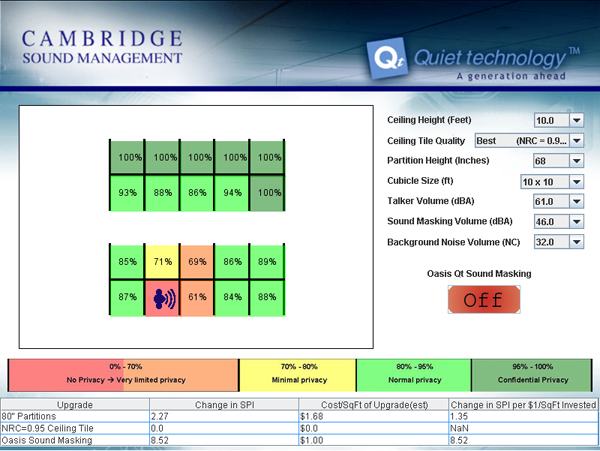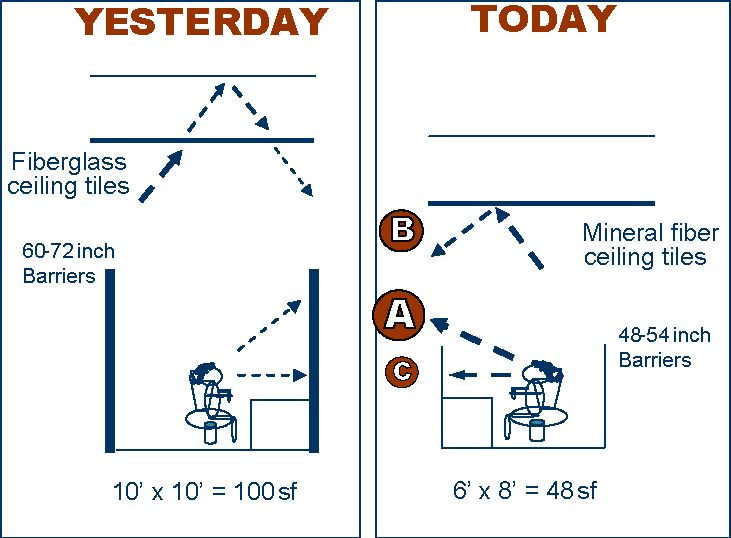Workspace Speech Privacy Calculator
New software for predicting acoustical privacy in the workplace:
an application for novices and experts
Popular version of paper 1pAA9
Presented Monday afternoon, June 4, 2007
153rd ASA Meeting, Salt Lake City, UT

Fig.1 Screenshot of Speech Privacy Calculator
A common concern facing consultants, designers and facility managers is estimating the acoustical comfort of an open plan office before the space is constructed. Current trends in workplace design have reduced privacy by lowering cubicle partition heights and removing walls (green design) while simultaneously realizing the importance of information security, particularly in healthcare, finance and corporate management. While excessive noise from office equipment or external sources certainly may be an issue, the most common concern is the lack of acoustical privacy – or freedom from distraction – caused by intruding speech from other occupants of the space. It is well understood among acousticians that most people’s ability to concentrate at work depends on the lack of distractions from coworkers. If one is able to easily hear and understand the conversation in the adjacent cubicle, is difficult to concentrate on the task at hand. On the other hand, if one understands only a word or two of a coworker’s conversation, or even an occasional sentence, it is much easier to concentrate and overall workplace productivity is enhanced. For healthcare and other information-sensitive practices, the protection of private conversations is crucial and often required by law.
This paper describes a computer application easily used by lay people as well as acoustic experts to estimate office acoustic privacy and the cost of various alternative office constructions and materials to achieve a desired level of privacy.
One standardized metric for intelligibility of speech is the Articulation Index (AI). A similar, more intuitive metric is the Speech Privacy Index (SPI) which has a range of values from 0% (no privacy) to 100% (complete freedom from distraction). A number of software tools are available for acoustical consultants and other experts to predict AI and SPI of an office environment. However, most do not prioritize the various components that contribute to satisfactory privacy and all require that the user be knowledgeable about these components in order to use the software.
To our knowledge, no other tools have provided relative cost information crucial for the value engineering judgments that constrain every design project. Unless an individual is well versed in office acoustics and has detailed data at hand for the construction and materials to be used, these tools are not particularly efficient in determining the tradeoffs that must be made to assure satisfaction.
For instance, should partial-height barriers between work stations be increased in height 6 inches, or should a high performance ceiling with certain sound absorption characteristics be substituted for another with different absorption characteristics? Or should a sound masking system be installed?
The software described here, the Speech Privacy Calculator or SPC, permits these prioritizations in real time, graphically. The software is available for free from Cambridge Sound Management’s website at http://www.cambridgesoundmanagement.com/, and can be either run quickly online or downloaded for subsequent analysis. SPC analyzes the acoustical characteristics of the workstation and the important contributors to speech privacy and installation cost, including workstation size, barrier height and sound transmission, the sound absorbing characteristics of the ceiling and its height, and the relative value of a sound masking system. For particular installation requirements or customized use by an acoustic professional, one can adjust masking, speech, and background noise levels with simple drop-down menus.
One innovative aspect of the software is that it analyzes not only the privacy of adjacent workstations but also the collective privacy among multiple cubicles in a typical layout, including more distant workstations. CSM has found it necessary to include this feature because in our experience most clients are satisfied with privacy conditions if alternate workstations achieve so-called normal privacy for normal voice, which is defined by standards as having an SPI of at least 80% to 85% for people speaking at average voice levels. In the past this criterion has normally been applied to adjacent workstations, but on the basis of CSM’s considerable experience with open plan installations, this appears to be overly stringent acoustically (except in cases where confidential privacy is required). Moreover, achieving 80% SPI is often not feasible with today’s insistence on lower partition heights and more open designs.
Another important feature of the software is the capability to quickly calculate privacy and cost implications graphically and dynamically. By using easily understood drop-down boxes, the user is able to input various parameters efficiently and see the result in real time. Thus a wide range of options can be analyzed rapidly.

Fig.2 Open office acoustics primer
Contemporary open office designs with low partitions greatly diminish the benefit of a high performance ceiling because the strength of intruding speech sound is determined primarily by the sound path between the talker and listener diffracted over the partition (A) rather than by the sound reflected from the ceiling (B) or sound through the barrier (C) . The diffracted sound between adjacent workstations can be calculated knowing only the barrier height, its weight, and the elevation of the talker and listener. If diffracted sound is to be analyzed for two intervening barriers, the distance between them must also be known. Since the easiest path for speech to leak between offices is path A, it is particularly important to be able to calculate its strength accurately. Often the second important path is the ceiling path - sound spreading out from the talker and impinging on the ceiling where a percentage is absorbed and the remaining reflected back down to the listener. In most cases the strength of this speech path can be estimated satisfactorily knowing only the Noise Reduction Coefficient (NRC) and the ceiling height, both parameters easily available to even the non-technical user. If the sound transmission through a particularly lightweight barrier is too low, it may also be a factor so the published Sound Transmission Class (STC) of the partitions may be changed as well. Finally, the talker position and direction is often a factor and this can be adjusted with a click of the mouse.
Because speech intelligibility is essentially a speech-to-noise ratio issue, the last important dimension of office privacy to consider is the degree of continuous ambient, or background, noise in the space. From a privacy standpoint, every decibel of increased background noise is just as useful as another decibel of attenuation between workstations. Ambient noise is often from HVAC systems, but can be more easily controlled through use of an electronic sound masking system. Contemporary low-partition office designs significantly increase the need for masking systems because low partitions absorb little to no sound. Accordingly, the SPC provides a drop down box for the user to input expected background noise and a button to turn on sound masking.
Often, as determined by the SPC figures and the accompanying value engineering grid, adding electronic sound masking to a space has more of an impact on speech privacy – and at a much lower cost – than alternative solutions involving furniture type, placement or use of absorptive materials. Each office environment is unique, but the Speech Privacy Calculator is an essential tool for any design professional attempting to estimate acoustical properties of a space – either existing or under development.